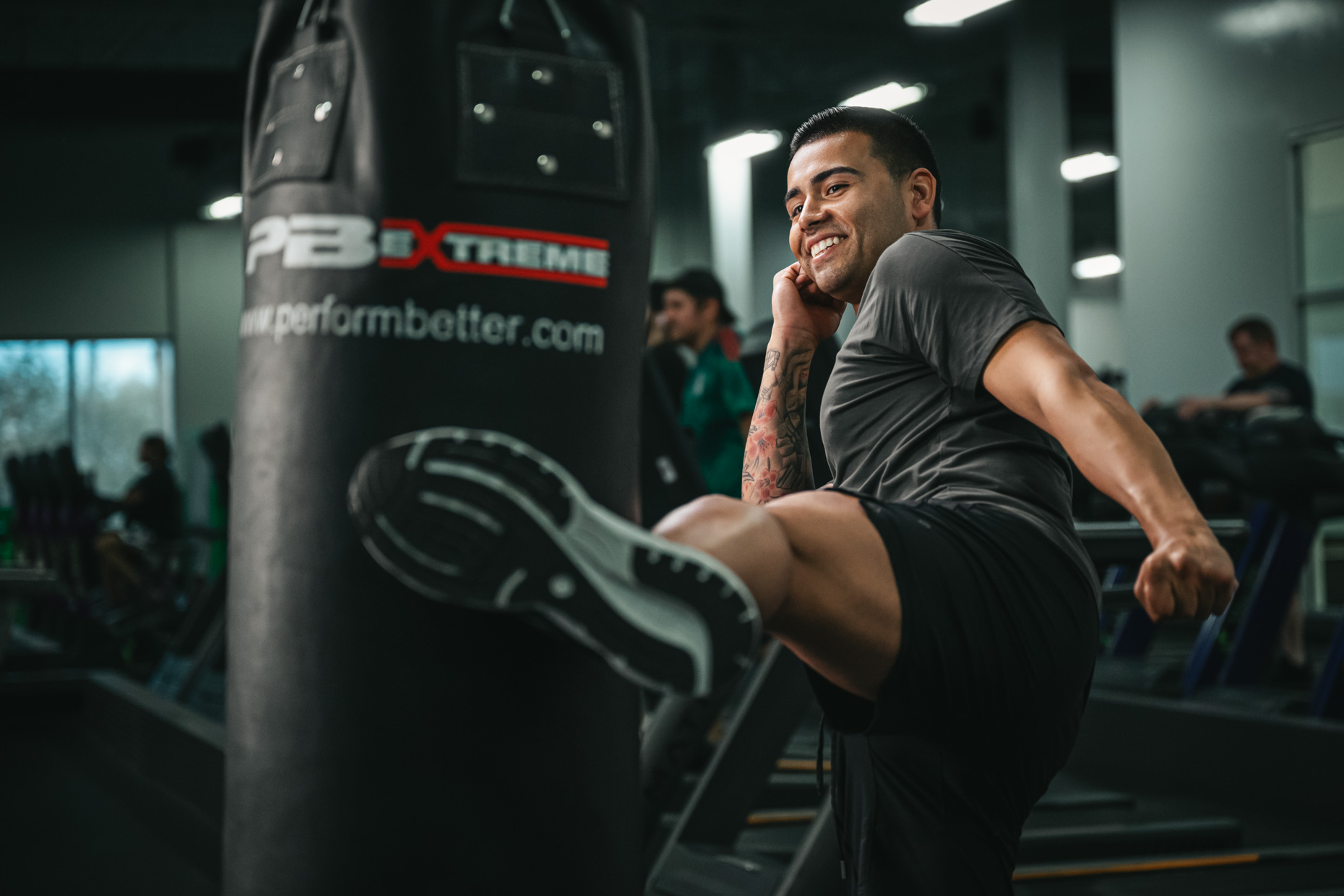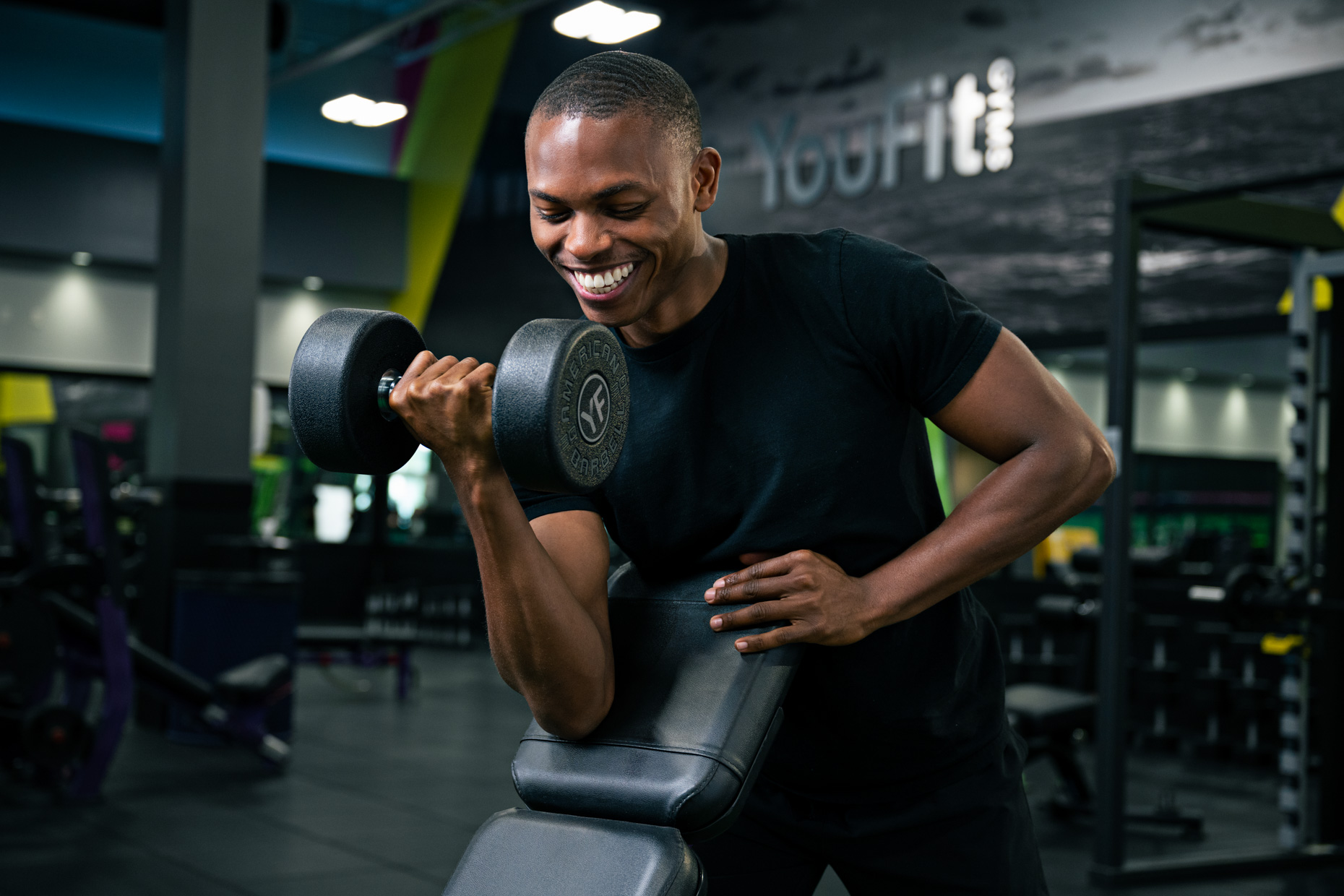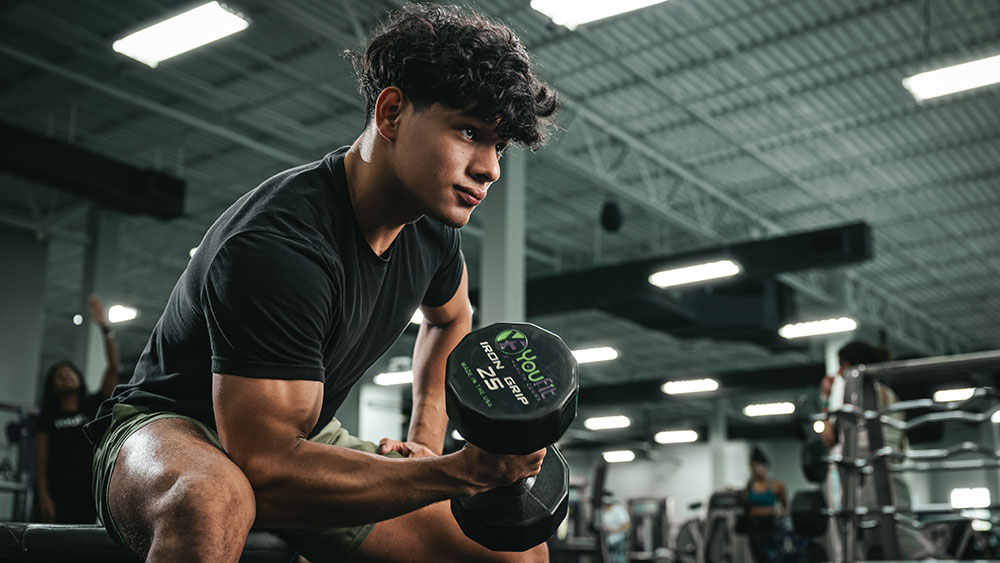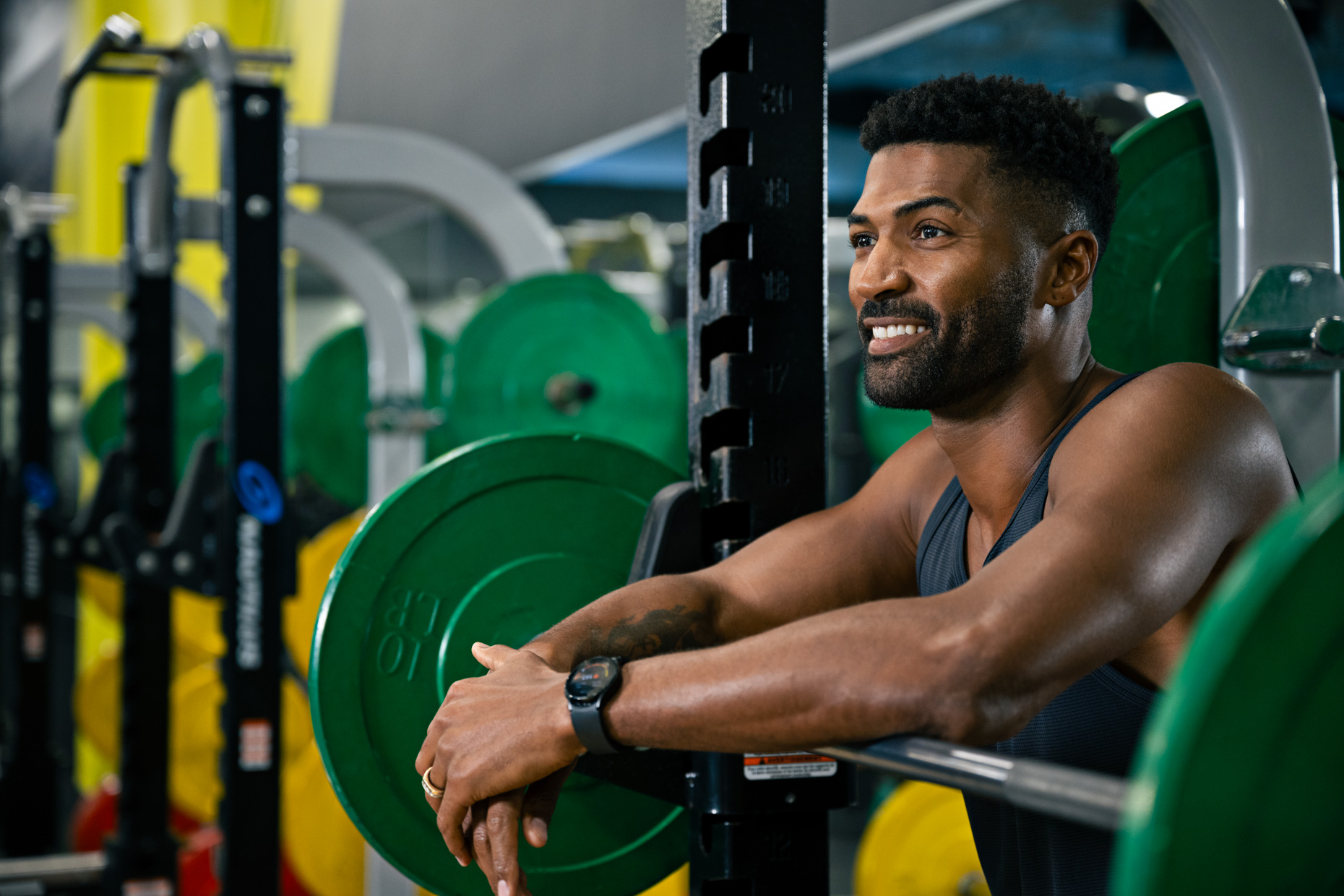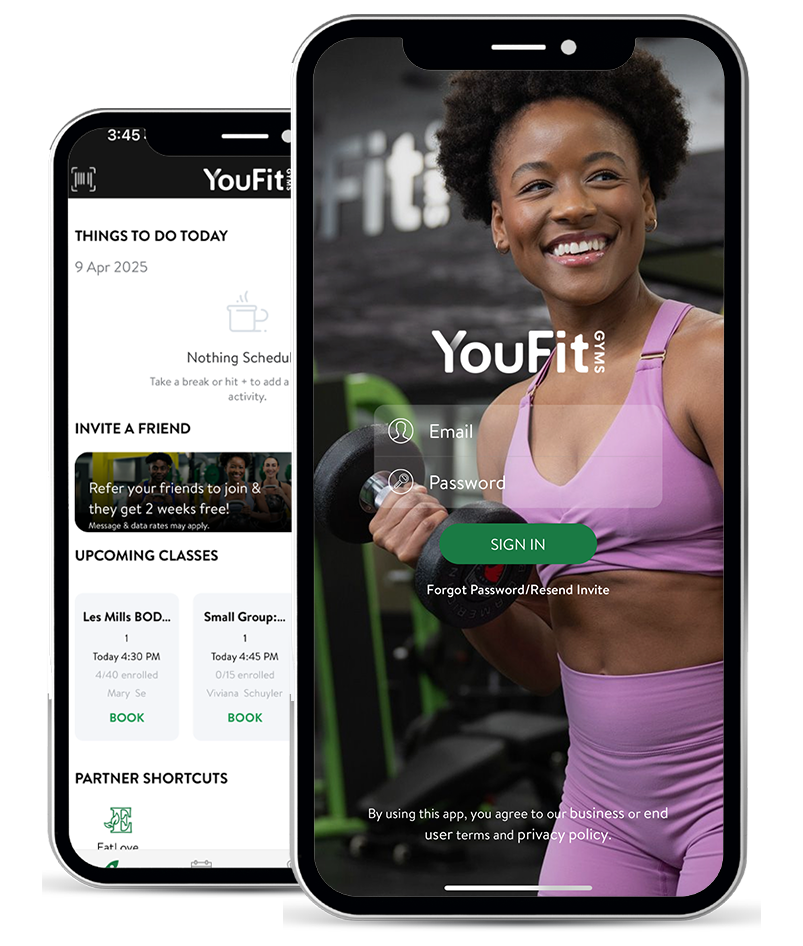Written by YouFit Gyms Personal Trainer
J. A. Clifton
From what you put into your body to how well you sleep, there are several ways to soothe sore muscles that are directly in your control. Of course, feeling some post-workout soreness is by no means a bad thing. In fact, part of the reward for pushing yourself in the gym is that unmistakable feeling of fatigue after a tough training session.
But even if delayed onset muscle soreness (more on that later) provides some satisfaction for your sweat-inducing efforts, your goal should be to recover as quickly as possible so you can conquer your next workout.
If sore muscles are keeping you sidelined longer than you’d like, learn more about why they can become a problem in the first place. Then, follow the five-step guide below to start soothing that soreness away so you stay on schedule, smash more PRs, and see results in the mirror!
What Causes Sore Muscles?
Whether you’re a novice or a pro, you’re more than likely going to feel sore within a day of working out. For some people, it might not take long–sometimes in just a few hours—for that effect to kick in. For others, it could take 24 hours.
On average, delayed onset muscle soreness (DOMS) occurs between 12-24 hours after a workout. Symptoms range from swelling to reduced range of motion to tenderness to the touch. The mildly painful fallout from hitting every rep in your program can last for one to three days–depending on how you approach the recovery process.
Why does DOMS happen?
While lactic acid buildup has often shouldered the blame, it’s actually not the reason you may feel sore, stiff, and slightly fatigued
When you lift weights, you create microscopic tears in your muscle fibers. While this is necessary to help you become stronger and healthier in the long run, your body’s short-term response is to ramp up inflammation. Combine that with potential dehydration and loss of electrolytes from breaking a serious sweat and you have the makings of muscle soreness and short-term loss of strength.
How to Soothe Sore Muscles: 5 Science-Backed Options
How quickly your muscle soreness goes away boils down to how proactive you are about combating it. Your fitness plan should be centered around daily staples like fueling up with nutrient-dense foods and following a morning routine. Those habits will set the stage for a smooth recovery and overall success.
Still, muscle soreness is an inevitable reality of resistance training. But just like before and during your workout, you can do things in the post-workout window to get back on track quickly.
Here are five science-backed ways to soothe sore muscles that you should implement immediately:
Become friends with a foam roller
If you want to perform at your best, you need to embrace the idea of getting a little uncomfortable. And when it comes to “No pain, no gain,” nothing encapsulates that mantra better than the good ole’ foam roller.
Never used one before?
Warning: Prepare for some mild discomfort…and a little bit of pain.
However, I promise becoming friends with a foam roller will pay off for the rest of your life.
While stretching is typically viewed as the key to resolving sore, tight muscles, your first step should be to work on a myofascial release. And when it comes to reducing DOMS and increasing flexibility and range of motion, spending some time on a foam roller can pay big dividends. A 2015 study on foam rolling as a recovery tool found that it not only improved quadriceps tenderness but also had a positive effect on performance.
As you lay on the foam roller, search for specific spots that are particularly tender and sore–and remain there for at least 30 seconds. You can try different angles to find one that provides the most relief. Areas to target include the glutes, quadriceps, hamstrings, upper back, and calves.
Trainer’s Tip: Steer clear of rolling over small joints like your ankles, elbows, and knees, as well as the lumbar spine.
Dedicate time to active recovery
Stop and think about how hard you work in the gym. Picture yourself pumping out reps on the bench press. Envision yourself finishing your final set of squats on #LegDay. Feel your abs burning as you crank out five more sit-ups to complete your core workout.
That amount of effort and commitment you put into working out must be put into active recovery.
What exactly does that involve, though?
The term “active recovery” encompasses a wide range of activities and practices. Rather than sitting around waiting for your soreness to subside, try a low-intensity form of cardio like walking, swimming, or biking to help increase blood flow and remove waste from your muscles. Or, close your blackout curtains, light a candle, and go through a 30-minute yoga practice to work on your flexibility and take some stress off your mind.
Just how effective can yoga be at aiding recovery?
A 2004 study on 24 women volunteers found that the yoga-trained participants demonstrated less peak muscle soreness at 24 and 48 hours after eccentric exercise compared to the control group.
Ultimately, the key takeaway should be to keep moving if you want to return to action faster.
Get quality sleep
One of the most underrated aspects of health and overall wellness: sleep hygiene. It’s one thing to watch your favorite Netflix show or scroll through Instagram until you pass out in bed. It’s another to power down all your devices and go through a sleep routine to ensure you get the most out of this prime opportunity for recovery.
Remember that resistance training results in small tears in your muscle fibers. When you rest, your body can dedicate resources toward repairing the damage caused by high-intensity exercise. However, if you don’t adhere to a consistent sleep schedule, consume sugary snacks, or stare at a screen as you wind down, you might as well say goodbye to getting a good night’s rest.
Need further proof that you should prioritize quality sleep?
According to the International Journal of Sports Medicine, sleep is arguably the single most important factor in exercise recovery. As a matter of fact, the conclusion of the 2019 review on the relationship between sleep hygiene and optimizing recovery in athletes summed it up perfectly:
“Therefore, the old saying “you snooze, you lose” should actually read to athletes, “You snooze (more), you win.”
Focus on hydration and nutrition
Another key to soothing sore muscles is consuming the right foods. Protein is vital in the post-workout window, as you need this critical macronutrient to repair and grow tissue. You can obtain protein in a variety of forms, including chicken, fish, beef, eggs, and yogurt. Add a whey protein shake to your daily intake and you’ll be well on your way toward hitting your protein goal.
It’s also a smart idea to consume foods with anti-inflammatory properties. Find ways to incorporate turmeric, green leafy vegetables, and almonds into your diet. Plus, you can add low-glycemic berries to your yogurt or smoothie for antioxidants and inflammation support.
Of course, you also have to stay disciplined about drinking water. Hydration isn’t just important for survival; it’s necessary for optimal performance. A 2022 study on endurance performance found that hydrogen-rich water consumption positively affected muscle performance, lactate response and alleviated DOMS after resistance training.
Hold yourself accountable with both your hydration and your nutrition. Both your muscles and your mind will thank you for it.
Take an Epsom salt bath
Put on some relaxing music, turn down the lights, and help soothe your sore muscles by kicking back for a bath. Only instead of adding bubbles for fun, pour in some Epsom salt for recovery purposes.
Why add this specific salt to your tub?
A study conducted at the University of Birmingham found that a 12-minute soak in an Epsom salt boosted sulfate and magnesium levels. Besides being beneficial for protein formation, muscle movements, and energy creation, magnesium is also important for sleep quality.
Utilizing all five of the steps outlined above to soothe sore muscles will put you in the best position to power through your next workout–over and over again.



